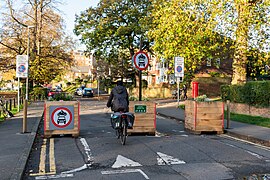Modal filter

A modal filter, sometimes referred to as a point closure,[1] is a road design that restricts the passage of certain types of vehicle. Modal filtering is often used to help create a low traffic neighbourhood (LTN), where motor traffic is diverted away from residential streets[2][3] and instead toward feeder roads. Modal filters can be used to achieve filtered permeability within a transport network,[4][5][6] and can encourage walking and cycling through more pleasant environments and improved safety.[7]
Modal filters can be implemented through the use of barriers such as bollards, boom barriers and planters, though filters can also be implemented virtually through the use of automatic number-plate recognition cameras and road signs, which can allow residential motor access while prohibiting passing motor traffic.[4]
Gallery
-
A trial modal filter using easily moved planters in London.
-
A sign explains what kind of traffic is allowed through the modal filter.
See also
References
- ^ "Point Closure | Cycling Embassy of Great Britain". www.cycling-embassy.org.uk. Archived from the original on 2023-02-02. Retrieved 2020-11-10.
- ^ Taylor, Matthew (2020-05-18). "'A new normal': how coronavirus will transform transport in Britain's cities". The Guardian. ISSN 0261-3077. Archived from the original on 2020-11-10. Retrieved 2020-11-10.
- ^ Aldred, Rachel; Goodman, Anna (2020-09-10). "Low Traffic Neighbourhoods, Car Use, and Active Travel: Evidence from the People and Places Survey of Outer London Active Travel Interventions". Findings: 17128. doi:10.32866/001c.17128. Archived from the original on 2021-04-29. Retrieved 2020-11-11.
- ^ a b Aldred, Rachel; Croft, Joseph (2019-03-01). "Evaluating active travel and health economic impacts of small streetscape schemes: An exploratory study in London". Journal of Transport & Health. 12: 86–96. doi:10.1016/j.jth.2018.11.009. ISSN 2214-1405. S2CID 133809626.
- ^ "Modal filter | Cycling Embassy of Great Britain". www.cycling-embassy.org.uk. Archived from the original on 2020-11-10. Retrieved 2020-11-10.
- ^ Parkin, John (2018). Designing for Cycle Traffic. London, UK: ICE Publishing. p. 56. ISBN 9780727763495.
- ^ "Traffic Management Act 2004: network management in response to COVID-19". GOV.UK. Archived from the original on 2020-11-13. Retrieved 2020-11-14.


